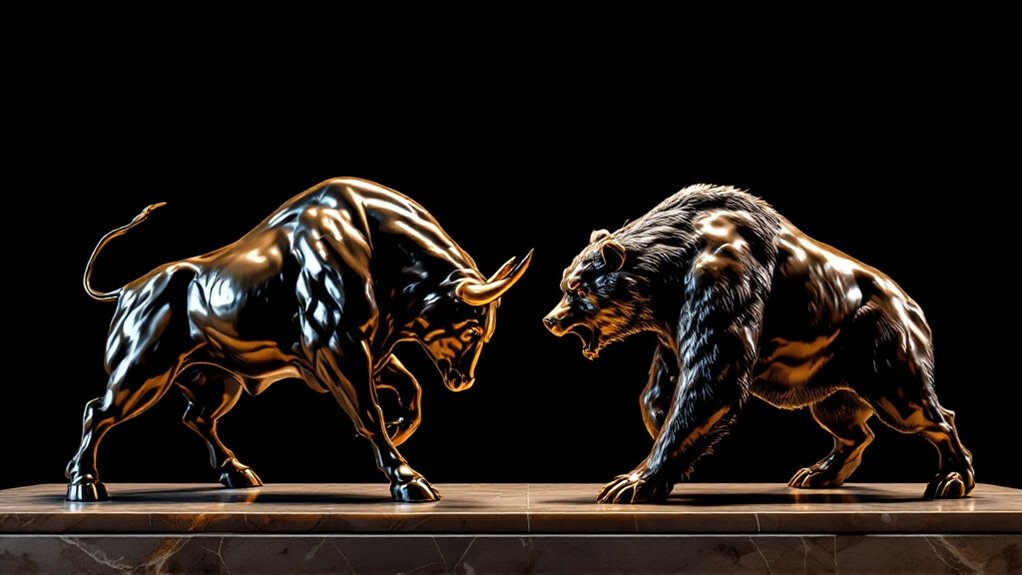Bull and bear markets signal dramatic shifts in stock prices and investor psychology. Bulls charge forward with 20% gains from recent lows, turning average folks into overconfident trading wizards amid economic optimism. Bears growl their way down with 20% drops from peaks, spreading panic and fear as portfolios shrink. While these market cycles are predictable, timing them is about as easy as herding cats. The real story lies in understanding what drives these wild swings.

The world of finance can be a zoo – especially when it comes to bulls and bears. These two animals represent the fundamental forces that drive market psychology, and their impact on stock prices can make or break portfolios. Bulls charge upward, bears swipe downward. It’s that simple.
Bull markets are the good times – when stock prices climb steadily and investors feel like financial geniuses. During these periods, the economy usually hums along nicely, with low unemployment and strong business performance. Companies rake in profits, and everyone wants a piece of the action. Supply gets tight, demand soars, and prices just keep climbing. The typical threshold for declaring a bull market? A 20% increase from recent lows. Historical data shows bull markets typically last 1,866 days on average.
In bull markets, optimism runs wild as rising stocks turn average investors into Wall Street wizards and everyone rides the profit wave.
Then there’s the dreaded bear market. When stocks drop 20% from their peaks, the bears come out to play – and it’s not pretty. The economy often stumbles, unemployment rises, and investor confidence takes a nosedive. Fear replaces greed as the dominant emotion. Companies struggle, profits shrink, and suddenly everyone’s looking for the exit. Historical records show median declines of 33% during bear markets.
These market cycles are as predictable as they are unpredictable. Sure, they’re guaranteed to happen, but timing them? Good luck with that. The economy expands and contracts like a breathing organism, dragging market sentiment along for the ride. Sometimes it’s just a quick correction – a mini-bear that doesn’t quite hit that 20% threshold. Other times, it’s a full-blown market meltdown. Smart investors often use portfolio diversification to protect against market volatility.
The psychological impact is real. Bull markets breed overconfidence – investors start thinking they’re Warren Buffett’s smarter cousin. Bear markets trigger panic selling, as fear overwhelms logic. Smart money knows both reactions are usually wrong.
History shows markets eventually recover from downturns, delivering positive returns over the long haul. But try telling that to someone watching their portfolio shrink in real-time. Markets are mathematical in theory, emotional in practice. That’s just how this financial zoo works.
Frequently Asked Questions
How Long Does the Average Bull Market Typically Last?
Historical data shows varying bull market durations, ranging from 9.6 months to 6.6 years. Using the S&P 500 benchmark, the average bull market has lasted approximately 4.2 years since 1942.
Can Investors Profit During Both Bull and Bear Markets?
Investors can profit in both market conditions through different strategies – buying stocks during bull markets for appreciation and using defensive investments or short-selling techniques during bear markets.
What Triggers the Transition Between Bull and Bear Markets?
Shifts between bull and bear markets are triggered by major economic indicators, shifting investor sentiment, government policies, and external events like wars, pandemics, or technological breakthroughs affecting market confidence.
Which Sectors Perform Best During Bear Markets?
Defensive sectors including utilities, consumer staples, and healthcare typically outperform during bear markets. These sectors provide essential services and maintain stable demand regardless of economic conditions.
How Do International Markets Affect Bull and Bear Market Cycles?
International markets influence bull and bear cycles through global economic interconnections, trade relationships, financial system linkages, and investor sentiment across regions, creating ripple effects that impact market performance worldwide.





